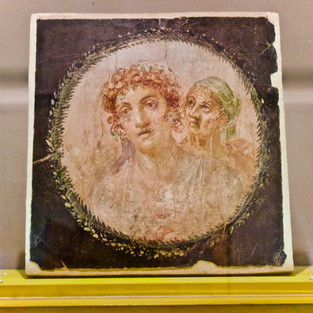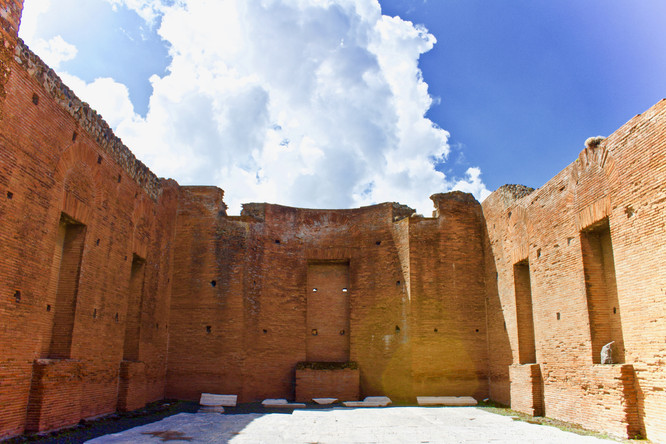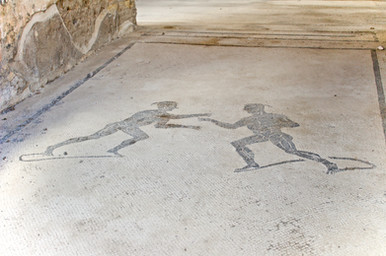Pompeii, a City Resurrected
- Emily Fata
- Jun 21, 2019
- 11 min read
Updated: Jul 30, 2019
After waiting nearly a quarter century to visit this archeological site, Wanderous Affair's editor-in-chief, Emily Fata, finally had the opportunity to walk the ancient city of Pompeii. What she found exceeded all expectations, making this awe-inspiring place one she will never forget.

Erupting between August 24 and 25 or in October or November (a debate sparked by weather patterns on the days of eruption) of 79 AD, over a period of two days and two nights, the city of Pompeii was completely buried under four to six metres (thirteen to twenty feet) of volcanic ash and pumice. It then lay buried for centuries upon centuries, until its rediscovery in 1748. The total population of both Pompeii and the nearby city of Herculaneum was between 16,000 to 20,000; however, though the remains of over 1,500 people have been found between the two cities, the actual death toll from this 66 hectare site is still unclear.
Today, you can still see Mount Vesuvius, a stratovolcano built up from alternate layers of lava and ash, looming in the distance. It's hard to imagine that this docile looking 'mountain' is actually one of the most dangerous volcanoes in the world, one that has claimed the lives of thousands of people over the millennia... and that may come to claim the lives of many more in the future.
Capitalizing on the opportunity to explore Pompeii's stunning city walls before nature may run its course once again, is something that I will be eternally grateful for.

Just a short twenty-five kilometres (sixteen miles) southeast of Naples, this UNESCO World Heritage site was once a major Mediterranean port, as well as a resort enclave for wealthy Romans in the region of Campania. Though two kilometres (about one mile) inland in the modern day thanks to Vesuvius extending the shoreline, the city would have been much closer to the sea at the time that it was last inhabited in 79 AD.
Upon passing through the admissions line and purchasing your 15€ ticket, you enter the city by way through the Marine Gate in Region VII of the city. However, prior to arriving at this point, you first walk past the Suburban Baths. Unlike the public baths used by most citizens of the city, the Suburban Baths were private and contained an (illegal) brothel on the upper level. Lovely, vibrantly painted erotic images lined the walls of the baths, giving patrons a hint as to the services they could pursue upstairs, should they wish.
Along with lavish decorations, these buildings also contained frescoes of naval warfare and life at sea, with decorated mosaics of Cupids handing their bows over to Mars, the god of war. It also contained an artificial grotto with a waterfall flowing down from it, into a small, cold pool.
After making your way past these buildings and up to the Marine Gate, you have a chance to continue into the city itself, or make a short detour into the small Pompeiian museum, in which you may enter through a door found under the arched gateway. We opted to see what the museum contained, and I'm so glad that we did.
In addition to a large number of beautiful relics unearthed by archeologists, including terracotta pottery, small paintings, sculptures, jewellery and even carbonized foodstuffs like bread and olives, they also offered a glimpse into the stunning mosaics that decorated the inside of people's homes, as well as public structures (an example is pictured in the collage above, with photos that I took).
I'll talk more about the city's intricate mosaics in a bit.
The museum also housed poignant plaster casts of the bodies (see image of the cast of a young child, on the left in the above collage of photos I captured) unearthed in Pompeii. They were made by filling in the empty space where citizens and even animals decomposed, with plaster; once their muscles, tissues, and skin melted away from their bodies after being coated with the weight of tonnes of ash and pumice, archeologists were able to uncover the exact positions and see the fearful facial expressions in which these people had died.
They still contain the bones of the deceased, some clearly displaying their teeth through parted 'lips'. With just this small glimpse into their daily lives, researchers are able to determine where the person fell in the social hierarchy, based on their diet. CAT scans can also provide insight into their ages, sex, and health, among other things.
Since it is believed that the eruption occurred simultaneously with a multi-day festival in honour of the emperor Augustus (he had died 65 years prior and had just been named a god), there were many more people in the city than there typically would be; therefore, it can be assumed that there were more tragic deaths than there would have been, had Vesuvius erupted during a time of year when no major events were taking place (festivals, sporting events at their local amphitheatre, or otherwise).

Further, the lead up to the eruption of Vesuvius coincided with the Vulcanalia Festival in honour of Vulcan, the god of fire and volcanoes. In fact, these celebrations had occurred just one day before the eruption took place. Because of this, warning signs of Vesuvius' impending eruption — earthquakes, a smoking mountaintop — were viewed as being signs that the god was content with their celebrations for him, rather than warnings to evacuate the city and surrounding area to seek safety.
Instead, the people of Pompeii were faced with what could have been escapable horrors. Though written two decades after the destruction of Pompeii, an eyewitness named Pliny the Younger, a Roman administrator and poet, wrote to a friend describing what he had experienced years earlier:
"You could hear the shrieks of women, the wailing of infants, and the shouting of men; some were calling their parents, others their children or their wives, trying to recognize them by their voices. People bewailed their own fate, or that of their relatives, and there were some who prayed for death in their terror of dying. Many besought the aid of the gods, but still more imagined there were no gods left, and that the universe was plunged into eternal darkness for evermore."

Though the last moments living in Pompeii were undeniably dark, both literally and metaphorically, it was not always so.
Keeping an eye peeled on the city's fine details, you may spot ancient graffiti — carvings made directly into the sides of buildings — that are thousands of years old. These give inquisitive visitors an even better look into the average daily life of Pompeii's populace. From etchings of then-famous gladiators near the amphitheatre, to love notes comparing a man's lover to Venus (“You are Venus”, says one affectionately, and another, “If you have not seen the portrait of Venus by Apelles, look at my girlfriend, she’s just as beautiful as her”), it's clear that many of these people had lived colourful and lively existences. To say the least, these people were certainly entertained.
As in the modern day, love was a common topic in the city; poetic love was just as accepted as prostitution; all aspects of human sexuality were considered part of daily life, not a source of prejudice. Such forward thinking was not only only advanced in their perspectives, but also in the ways in which the city functioned as a whole.

Pompeii's web of one-way city streets served as a stone pathway for carts to pass through, as sidewalks for pedestrians, as well as a method of draining rainwater (which trickled out from pipes leading away from buildings and out into the roads). From these escape points, water would then flow along drains — indentations running parallel to the streets on either side — away from the city.
While walking through Pompeii, you may notice massive stones spaced out in a line horizontally across the road. It wasn't until watching an incredible documentary once returning home that I finally discovered what these were for: pedestrians would use these as cross-walks of sorts, stepping over the road to avoiding dragging their togas through the mud and grime coating the regular streets directly beneath. Of all the photos I took, I only managed to capture one with these raised 'pathways', seen above in the foreground of an image I took of my grandmother while we explored the city.

It also housed a complex plumbing system, with over forty fountains to be found in the city (a good number of which tourists can fill up their reusable bottles at with clean water today). Many of the more lavish homes also had both hot and cold running water, which was used in everyday life without having to send servants out into the streets to the nearest fountain to fetch it in buckets.
When you think about how very long ago this time was, it helps put into perspective what a remarkable achievement in civil engineering their plumbing and sewage systems were. The fact that ancient Romans devised a method to bring fresh water to cities and towns from hundreds of kilometres away (not in the specific case of Pompeii however, as they were located near the shoreline of the sea) is astonishing. Their intricate sewage system, mentioned briefly above when discussing the layout of the streets, quite thoroughly whisked waste away.
But let's talk a bit more about the buildings you can still fall in love with in the city of Pompeii.

Perpendicular to the Forum in Region VII, you can find the Basilica (located in the adjacent Region VIII), constructed between 130 and 120 BC. Its area of 1500 square metres (over 4900 square feet) was the most visually stunning building located within the Forum and was used to conduct business as well as to administer justice. When in use, one could enter the Basilica from the Forum through any one of five entrances, located between towering pillars. Inside, there were three naves, a magnificent equestrian statue, and a richly decorated tribunal for judges to sit at during court hearings, located on the central western side. The surrounding walls were richly decorated with stucco, made to look like large blocks of marble.
You can also find what remains of many beautiful buildings in the nearby area, from public buildings, to shops, to people's homes.
In this roped off passage ways just off the site of the Forum and Basilica (pictured in the collage above, of photos I took), you can see a couple examples of the visual gems Pompeii still offers. Appreciating large buildings as a whole, small passageways leadings to hidden nooks and crannies, or even the intricate details on carvings of bronze and marble are meant to be valued.
After all, they were undoubtedly admired by the Pompeiians, who dedicated countless hours of time and energy into creating such a magnificent city for themselves to live in.
Another source of immense time and attention to details are their mosaics, often used as flooring. Mosaic ornamentation was frequently utilized to decorate the interiors of Pompeii's homes, with various stages of development throughout ancient years (which saw a shift in style and technique). The oldest examples are those with simple motifs, using tesserae (a small block of stone, tile, glass, or other material used in the construction of a mosaic) in patterns of rough workmanship. However, as time went on, the mosaics began to show refinement in their composition, with more beautiful colours being used, as well as more fine tesserae creating an overall masterpiece. Though the first period depicted mosaics characterized by the repetition of simple geometric motifs, 'future' works were more complex.
In the collage above of photos that I took while wandering through Pompeii, you can see the simpler geometric patterns of earlier days on the bottom right and upper left, with more complex images being portrayed on the lower left-hand side (two men wrestling, located in Palaestra of the Iuvene) and the middle right (dogs attacking a boar in a symbol of warding off evil, from one of the larger homes, House of the Boar in Region VIII). Not pictured, the House of Paquinius Proculus is also a stunning work of art, with mosaics that will sweep you off your feet.
However, it's not only the mosaic work of public buildings and wealthy citizens' floors that are to be admired, but also the Romans' colourfully detailed frescoes.

Frescoes, like the ones found in Palaestra of the Iuvenes — a private bath house in Region VIII — are crucial to uncovering the history of this ancient Roman culture. They depict not only what would have occurred within the very walls that they are erected in (as in the image above), but also offer a glimpse into their daily lives. From gods and goddesses and their related mythology, winemaking techniques, gladiatorial fights, popular cuisine, fashion, and representations of typical scenes from the market, gymnasiums, local bars, and idealized gardenscapes.
These painted works can be found throughout the entire city and are slowly deteriorating; indeed, they have spent more time exposed to the harsh pollution of the modern day than they ever spent in ancient times, when they were initially created. Because of this, specialists have spent years working to preserve what is left of these paintings and frescoes, as well as bring back to life what remains of them to their full glory.
More vivid art can be spotted within the Stabian Baths (pictured in the collage of photos I took, below), which are not only among the oldest known Roman baths, but are also a true testament to the fascinatingly advanced technology of the time.
Located just off of via dell'Abbondanza, you can find a pool to your left and the men's section to your right. Central, one could find dressing rooms, an adjacent frigidarium (cold baths), attached tepidarium (lukewarm bathing area), followed by the calidarium for hot baths. Each segment was heated accordingly, through a brilliant piping system in which the walls and double floors were able to circulate hot air rising up from the furnaces and braziers housed separately. Note how our Latin-based words "frigid" and "tepid" can be found prior to the suffix "-arium" (meaning "location"). For those of you that also speak some Italian, you'll know that the word for 'hot' is caldo, which explains the prefix of calidarium.
It was not uncommon to have separate bathing areas for each sex in these days, and women would have entered through a separate door (marked "Mulier"), in the north-west corner of the courtyard. This area would have had a similar layout, though the rooms were smaller and did not contain the same vibrant frescoes and decorations that their male counterparts had.
As well, while wandering through the courtyard of the baths, you may have the chance to spot one of three stray dogs living in Pompeii (at least, that's what I overheard a tour guide tell his group). The one I had the chance to meet was an adorable and docile creature, who sat on the marble steps leading into the baths. He people watched as tourists milled about, and gratefully tilted his head upward to any passerby who offered him a gentle pat on the head or scratch behind the ears.
Seeing a dog lazying around the baths was a simple reminder about the everyday life that the citizens of Pompeii once lived. It would not have been uncommon for dogs to wander the city streets in those days — in fact, as I mentioned earlier, plaster casts around the remains of dogs, undoubtedly people's pets, had been unearthed during excavations — and seeing him lying on the marble floors made it that much easier to transport myself back in time. It seemed that each step I took forward through this well laid-out city served to humanize the inhabitants all the more.

This connection with a people long gone has been safeguarded over millennia, something that is so incredibly rare, especially on such a massive scale as an entire preserved city. Because we have this one chance to step back in time, it must be salvaged and maintained to the best of our abilities. Centuries of exposure to the elements, and now tourists as well, are a threat to what remains of this ancient city. To think that future generations may not have the chance to admire the incredible patterned brickwork and designs (pictured in a collage of my photos below) is truly a tragedy.
A city that seems immortal after having survived multiple volcanic eruptions and being buried under ash and pumice for thousands of years will not remain invincible for much longer; in fact, it is slowly deteriorating, disappearing on us.
After spending an entire morning wandering through the labyrinth that is Pompeii, I found myself feeling equal parts grateful (that this entire city miraculously withstood centuries upon centuries of being buried) and solemn (that thousands of people died as a result of Vesuvius' eruption). Thoughts of that day in 79 AD make me think: casualties of this disaster had no idea that that fateful would be their last day... Therefore, how can I make today one to remember? How do I make today worth living?
Exploring Pompeii was definitely an ideal option.
X,
Emily
To read more of our posts on Italy, click here.











































What an amazing place to visit! I would love to visit Pompeii!